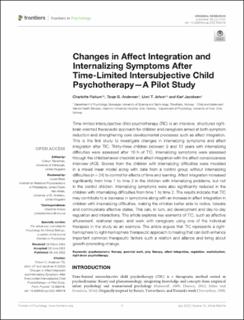| dc.contributor.author | Fiskum, Charlotte | |
| dc.contributor.author | Andersen, Tonje Grønning | |
| dc.contributor.author | Johns, Unni Tanum | |
| dc.contributor.author | Jacobsen, Karl | |
| dc.date.accessioned | 2023-02-27T15:47:16Z | |
| dc.date.available | 2023-02-27T15:47:16Z | |
| dc.date.created | 2022-07-08T14:13:27Z | |
| dc.date.issued | 2022 | |
| dc.identifier.citation | Frontiers in Psychology. 2022, 13 1-13. | en_US |
| dc.identifier.issn | 1664-1078 | |
| dc.identifier.uri | https://hdl.handle.net/11250/3054397 | |
| dc.description.abstract | Time-limited intersubjective child-psychotherapy (TIC) is an intensive, structured right-brain oriented therapeutic approach for children and caregivers aimed at both symptom reduction and strengthening core developmental processes such as affect integration. This is the first study to investigate changes in internalizing symptoms and affect integration after TIC. Thirty-three children between 9 and 13 years with internalizing difficulties were assessed after 10 h of TIC. Internalizing symptoms were assessed through the child behavior checklist and affect integration with the affect consciousness interview (ACI). Scores from the children with internalizing difficulties were modeled in a mixed linear model along with data from a control group without internalizing difficulties (n = 24) to control for effects of time and learning. Affect integration increased significantly from time 1 to time 2 in the children with internalizing problems, but not in the control children. Internalizing symptoms were also significantly reduced in the children with internalizing difficulties from time 1 to time 2. The results indicate that TIC may contribute to a decrease in symptoms along with an increase in affect integration in children with internalizing difficulties, making the children better able to notice, tolerate and communicate affective states. This can, in turn, aid development and day-to-day regulation and interactions. The article explores key elements of TIC, such as affective attunement, relational repair, and work with caregivers using one of the individual therapies in the study as an example. The article argues that TIC represents a right-hemisphere to right-hemisphere therapeutic approach to healing that can both enhance important common therapeutic factors such a relation and alliance and bring about growth-promoting change. | en_US |
| dc.language.iso | eng | en_US |
| dc.publisher | Frontiers | en_US |
| dc.rights | Navngivelse 4.0 Internasjonal | * |
| dc.rights.uri | http://creativecommons.org/licenses/by/4.0/deed.no | * |
| dc.title | Changes in Affect Integration and Internalizing Symptoms After Time-Limited Intersubjective Child Psychotherapy—A Pilot Study | en_US |
| dc.title.alternative | Changes in Affect Integration and Internalizing Symptoms After Time-Limited Intersubjective Child Psychotherapy—A Pilot Study | en_US |
| dc.type | Peer reviewed | en_US |
| dc.type | Journal article | en_US |
| dc.description.version | publishedVersion | en_US |
| dc.source.pagenumber | 1-13 | en_US |
| dc.source.volume | 13 | en_US |
| dc.source.journal | Frontiers in Psychology | en_US |
| dc.identifier.doi | 10.3389/fpsyg.2022.906416 | |
| dc.identifier.cristin | 2037719 | |
| cristin.ispublished | true | |
| cristin.fulltext | original | |
| cristin.qualitycode | 1 | |

